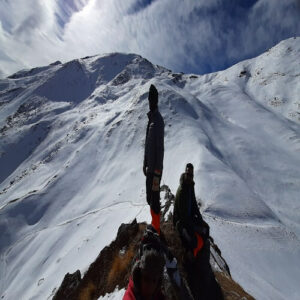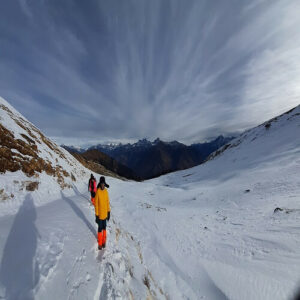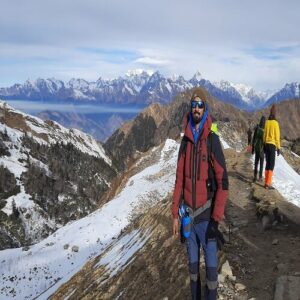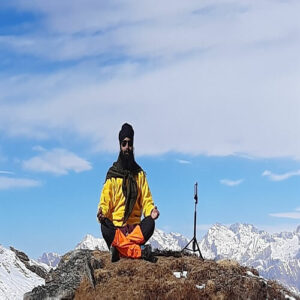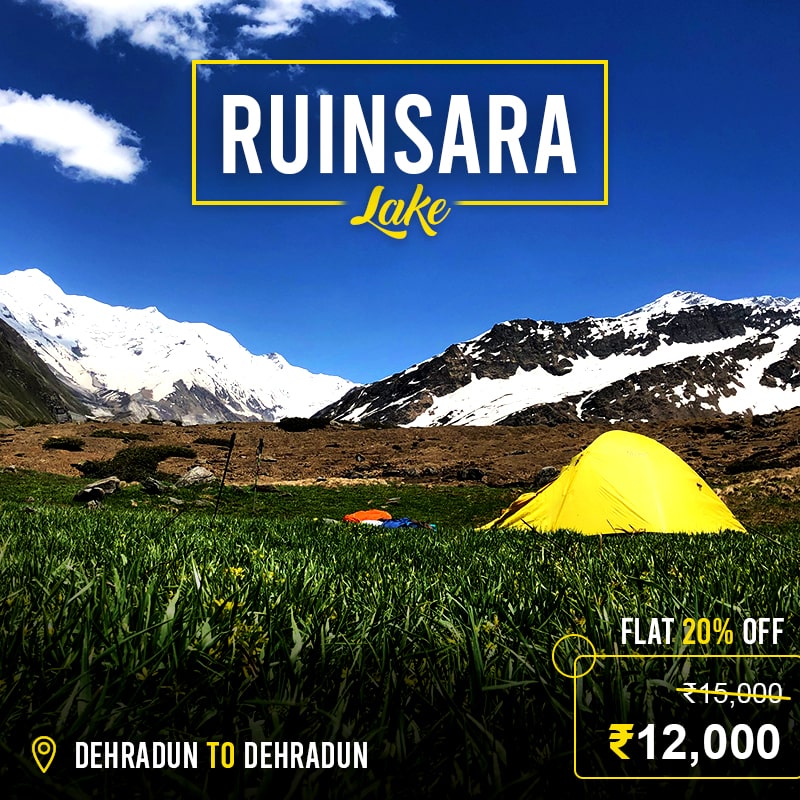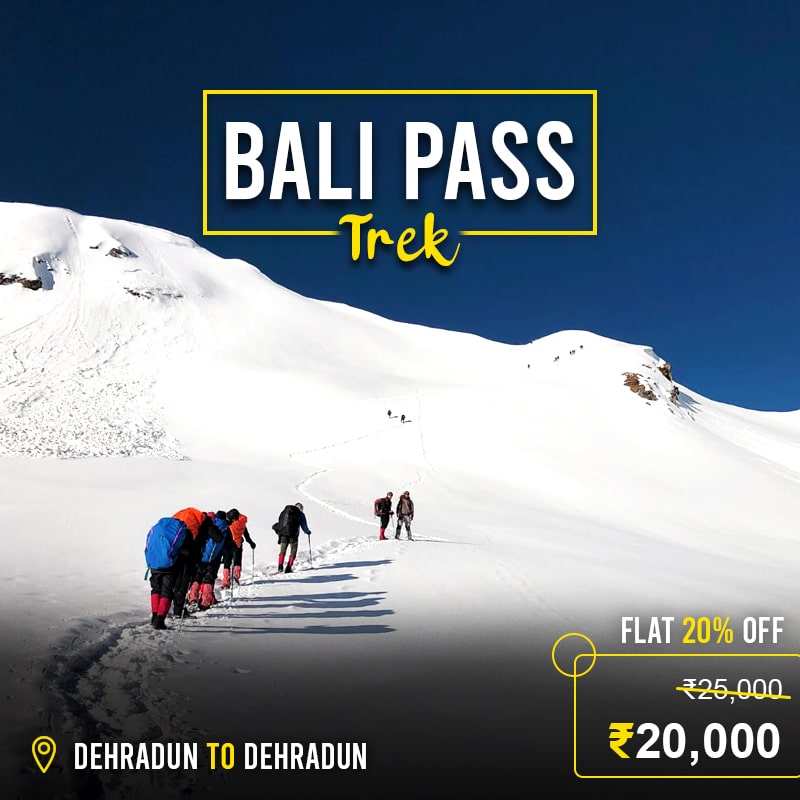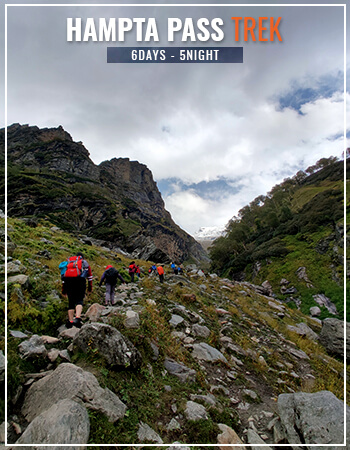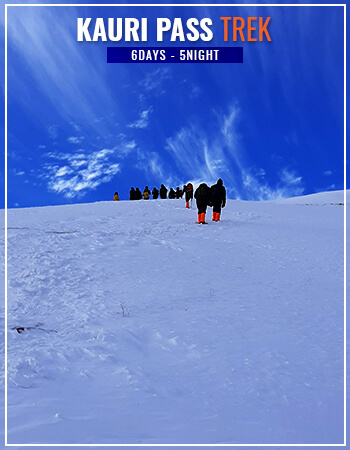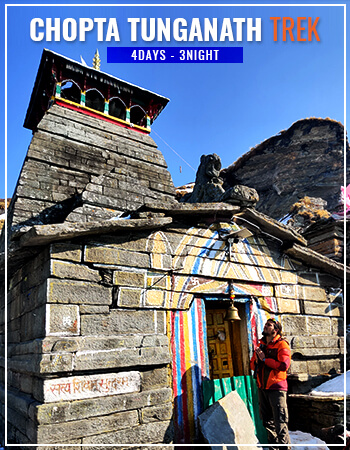Panpatia Col trek
12 Days - 11 Night
12 Days - 11 Night
17260 Ft
Low to Moderate
Uttarkashi
ABOUT
Panpatia Col trek
The Panpatia Col trek, which connects the holy pilgrimage sites of Kedarnath and Badrinath, is one of the most complicated and challenging treks in the Garhwal Himalayas. This high-altitude pass, at a staggering altitude of 5260M / 17260 ft, is sandwiched between two unnamed peaks that climb to a height of 5500M+. The Panpatia Col trek is only for seasoned trekkers and aspiring mountaineers who have previous trekking experience and knowledge of using ice axes, crampons, and roping up procedures, as it is one of the least traversed passes in the Indian Himalayas. It necessitates a high degree of health, as well as physical and mental stamina. Read More
The path passes by huge glaciers, crevassed snowfields, rugged moraines, and the never-ending 7-kilometer-long Panpatia snowfield, which is a delight for aspirational trekkers looking to cross this epic trek off their bucket list. The Panpatia Col Trek provides stunning views of Nilkantha, Balakun, Hathi Parvat, and Dhauliganga Hills.
SHORT ITINERARY
-
DAY 1
Joshimath from Dehradun
-
DAY 2
Alaknanda Camp from Joshimath
-
DAY 3
Shepherd Camp from Alaknanda Camp
-
DAY 4
Snout Camp from Shepherd Camp
-
DAY 5
Moraine Camp from Snout Camp
-
DAY 6
Parvati Gully Base Camp from Moraine Camp
-
DAY 7
Panpatia Snowfield Camp from Parvati Gully Base Camp via Parvati Col
-
DAY 8
Sujal Sarovar from Panpatia Snowfield Camp via Panpatia Col
-
DAY 9
Kachni from Sujal Sarovar
-
DAY 10
Nanu Chatti from Kachni
-
DAY 11
Ransi from Nanu Chatti
-
DAY 12
Backup Day
DETAILed ITINERARY
Day 1: Joshimath from Dehradun
Dehradub reporting at 7 am. From Dehradun, travel to Joshimath. Staying in a guesthouse for the night.
Day 2: Alaknanda Camp from Joshimath
On the road from Joshimath to Badrinath, we travel from Joshimath to Hanuman Chatti and cross the Alaknanda river on a suspension bridge from Khirao. After a short hike above the Khirao Ganga and Alaknanda confluence, we camp in a clearing. Dinner is served, and then it’s time to call it a night. Tents can be used for the night.
Day 3: Shepherd Camp from Alaknanda Camp
After a steady climb from the campsite, we make our way to the Khirao village today. During the summer, most Khirao villagers are either working on their terraced fields or moving to higher meadows. We arrive at our overnight campsite after a steep climb from the village to the treeline, followed by navigating the grassy slopes. Dinner is served, and then it’s time to call it a night. Tents can be used for the night.
Day 4: Snout Camp from Shepherd Camp
A quick stroll from Shepherd’s camp leads to the snout of the Panpatia glacier. The campsite is about a 10-minute walk from the snout. At the Snout camp, we pitch our tents and retire for the night.
Day 5: Moraine Camp from Snout Camp
Today’s hiking entails a long uphill climb on a never-ending moraine, which can seem monotonous at first, but it’s a pleasure to wind through patches of snow to pick up the pace and bring diversity to the walk. On one foot, a highly crevassed glacier drops almost vertically to the other, with views of prominent peaks like Neelkanth and Parvati looming high. You will get the first view of Chaukhamba from here. We have dinner and set up our tents at the moraine camp for the night.
Day 6: Parvati Gully Base Camp from Moraine Camp
Today’s trek takes us from the moraine camp to the base of Parvati Col, a short but steep climb that gets you closer to the Panpatia snowfield. We set up camp near the Parvati Col. Dinner is served, and then it’s time to call it a night.
Day 7: Panpatia Snowfield Camp from Parvati Gully Base Camp via Parvati Col
The trek today begins with a sharp ascent to the edge of the terrace, where the only path forward is across a steep snow and rock gully. To navigate this passage and reach the realm of pure snow, we’ll set up ropes. A series of gentle humps lead to the Parvati Col and the Panpatia snowfield, which is a large plateau of snow surrounded by lofty peaks. Chaukhamba rises majestically, and if you’re lucky, you’ll get a glimpse of Nanda Devi. After crossing the Parvati Col, you’ll arrive at the huge yet stunning Panpatia snowfield, where we’ll set up camp for the night. Dinner will be served, and you will be able to relax early.
Day 8: Sujal Sarovar from Panpatia Snowfield Camp via Panpatia Col
Today’s walk will take you around the Panpatia snowfield, which extends for miles. It’s a long stroll, but there’s very little elevation gain. After a brief ascent, you’ll arrive at the Panpatia Col, which offers breathtaking views of the surrounding ranges, glaciers, and vast snowfields. The descent from the Panpatia Col to Sujal Sarovar, our next campsite, is vertigo-inducing. For our overnight stay near Sujal Sarovar, we pitched tents.
Day 9: Kachni from Sujal Sarovar
We’re going to Kanchi Tal today. Kanchi is reached through a small pass a few meters above Sujal Sarovar, followed by a steep descent across snowy slopes and boulder zones. The Madhmaheshwar Ganga is visible from the meadow. This is the location of our campsite. Dinner is served, and then it’s time to call it a night.
Day 10: Nanu Chatti from Kachni
We’re going to Nanu Chatti today. It takes about 3-4 hours to get to Madhmaheshwar temple, which is located outside oak forests and connected to the road head at Ransi by a paved path. It’s a short walk through the forest to Nanu Chatti, a small settlement of summer homes for Gaundhar village residents.
Day 11: Ransi from Nanu Chatti
On the Madhmaheshwar Temple trail, walk to Ransi and then travel to Rudraprayag.
Day 12: Backup Day
In the event of inclement weather or other disturbances, this day will be used.
DETAILed ITINERARY
Day 1 Joshimath from Dehradun
Dehradun reporting at 7 am. From Dehradun, travel to Joshimath. Staying in a guesthouse for the night.
Day 2 Alaknanda Camp from Joshimath
On the road from Joshimath to Badrinath, we travel from Joshimath to Hanuman Chatti and cross the Alaknanda river on a suspension bridge from Khirao. After a short hike above the Khirao Ganga and Alaknanda confluence, we camp in a clearing. Dinner is served, and then it's time to call it a night. Tents can be used for the night.
Day 3 Shepherd Camp from Alaknanda Camp
After a steady climb from the campsite, we make our way to the Khirao village today. During the summer, most Khirao villagers are either working on their terraced fields or moving to higher meadows. We arrive at our overnight campsite after a steep climb from the village to the treeline, followed by navigating the grassy slopes. Dinner is served, and then it's time to call it a night. Tents can be used for the night.
Day 4 Snout Camp from Shepherd Camp
A quick stroll from Shepherd's camp leads to the snout of the Panpatia glacier. The campsite is about a 10-minute walk from the snout. At the Snout camp, we pitch our tents and retire for the night.
Day 5 Moraine Camp from Snout Camp
Today's hiking entails a long uphill climb on a never-ending moraine, which can seem monotonous at first, but it's a pleasure to wind through patches of snow to pick up the pace and bring diversity to the walk. On one foot, a highly crevassed glacier drops almost vertically to the other, with views of prominent peaks like Neelkanth and Parvati looming high. You will get the first view of Chaukhamba from here. We have dinner and set up our tents at the moraine camp for the night.
Day 6 Parvati Gully Base Camp from Moraine Camp
Today's trek takes us from the moraine camp to the base of Parvati Col, a short but steep climb that gets you closer to the Panpatia snowfield. We set up camp near the Parvati Col. Dinner is served, and then it's time to call it a night.
Day 7 Panpatia Snowfield Camp from Parvati Gully Base Camp via Parvati Col
The trek today begins with a sharp ascent to the edge of the terrace, where the only path forward is across a steep snow and rock gully. To navigate this passage and reach the realm of pure snow, we'll set up ropes. A series of gentle humps lead to the Parvati Col and the Panpatia snowfield, which is a large plateau of snow surrounded by lofty peaks. Chaukhamba rises majestically, and if you're lucky, you'll get a glimpse of Nanda Devi. After crossing the Parvati Col, you'll arrive at the huge yet stunning Panpatia snowfield, where we'll set up camp for the night. Dinner will be served, and you will be able to relax early.
Day 8 Sujal Sarovar from Panpatia Snowfield Camp via Panpatia Col
Today's walk will take you around the Panpatia snowfield, which extends for miles. It's a long stroll, but there's very little elevation gain. After a brief ascent, you'll arrive at the Panpatia Col, which offers breathtaking views of the surrounding ranges, glaciers, and vast snowfields. The descent from the Panpatia Col to Sujal Sarovar, our next campsite, is vertigo-inducing. For our overnight stay near Sujal Sarovar, we pitched tents.
Day 9 Kachni from Sujal Sarovar
We're going to Kanchni Tal today. Kanchni is reached through a small pass a few metres above Sujal Sarovar, followed by a steep descent across snowy slopes and boulder zones. The Madhmaheshwar Ganga is visible from the meadow. This is the location of our campsite. Dinner is served, and then it's time to call it a night.
Day 10 Nanu Chatti from Kachni
We're going to Nanu Chatti today. It takes about 3-4 hours to get to Madhmaheshwar temple, which is located outside oak forests and connected to the road head at Ransi by a paved path. It's a short walk through the forest to Nanu Chatti, a small settlement of summer homes for Gaundhar village residents.
Day 11 Ransi from Nanu Chatti
On the Madhmaheshwar Temple trail, walk to Ransi and then travel to Rudraprayag.
Day 12 Backup Day
In the event of inclement weather or other disturbances, this day will be used.
subscribe Now
Get Quote
DEPATURE DATE
Call- +91-8979108941 | +91-9458118063
Call- +91-8979108941 | +91-9458118063
Call- +91-8979108941 | +91-9458118063
Call- +91-8979108941 | +91-9458118063
Call- +91-8979108941 | +91-9458118063
COST INCLUSION
-
Pick and Drop Service from mentioned location
-
Fees for the guide and the chef
-
Camping facilities' rent
-
Entrance fees to the forest
-
To transport camping gear, a porter and mule are required. Please keep in mind that personal baggage can be borne by mules and/or porters for a fee
-
From the first day's dinner until the last day's brunch, both of the meals are vegetarian
-
Throughout the walk, you'll be staying in a tent or if possible, then in a guest house
COST EXCLUSION
-
No pickup and drop point from/for your hometown
-
Personal costs include things like tips, personal medications, and conference calls, etc
-
Apart from what is mentioned above, some transportation assistance during the trek
-
Porters/mules can carry personal luggage weighing up to 12 kg per bag per person for Rs 350 per day per bag
subscribe Now
Frequently asked question
- Footwear: The trekking boots which must be waterproof and snow proof, normal boots, floaters, and woolen socks.
- Backpack: (50 ltr), Daypack (20-30 ltr), Duffel bag.
- Clothes: Jacket and trousers that are both waterproof and breathable. Jacket (synthetic or down feather fleece), synthetic insulated trousers, poncho, sweatshirt, inner thermal (upper & lower), fleece, t-shirts, cotton trekking pants, shorts
- Season wise Clothes:
- Hand and head protection includes liner gloves, bandannas, sun hats, woollen caps, and face masks, among other things.
- Accessories: Sunglasses/goggles, anti-glare lenses, water bottle, hydra bag, and headlamp with spare bulb and extra batteries are all recommended.
- Trekking Gears: Toolkit for an emergency. Sunscreen, a toiletry pack, water purification pills, Ziploc packs, ear plugs, first-aid kit, and the necessary medications are all recommended.
- Camping Equipment: Sleeping bags of lining (extreme -5 to +5 Celsius if you have one), trekking sticks, and so on.
- Warm top/light micro fleece pullover/full sleeve T shirt – 2/3
- Water resistant/repellent trekking pants with an inner lining for added warmth- 2 High-quality windproof/water-resistant outer shell (jacket) with a proper hood
- Thick Fleece / Full-sleeve Woollen Jumper, Down Jacket with at least 600 fill capacity Innerwear with a thermal component (upper and lower)
- Woolen hat, inner fleece gloves, and outer water-resistant gloves
- 4–5 pairs of thick woollen socks and standard socks, scarf/muffler (optional)
- Waterproof Trekking/Hiking shoes with a thick heel and high ankles that are comfortable to wear. Sneakers/sport shoes are ideal for camp.
- Poncho or raincoat. A small, light-weight towel
- A hydration pack and an insulated water bottle (optional)
- Sunglasses with UV cover and the potential to cut light, as well as a cap or floppy hat to shield the strong sun off your skin (important when traversing through snow)
- Trekking pole or sturdy walking stick Lip Balm, Sunscreen Lotion
- Flashlight / torch (with extra batteries) Medications, if any special prescription is needed Toiletries for personal use
- Carry a rain cover over your luggage • Day pack/small bag that you can carry on your back all day to keep your essentials in
- Keep a few poly bags or plastic containers in your bag to place your things in if you need to in case of heavy weather.
Personal Medical Kit (MANDATORY FOR ALL)
- 10 Diamox tablets (to prevent AMS)
- Nifedipine – 5 pills Dexamethasone – one strip
- 6 tablets of Crocin (fever)
- 4 tablets of avomine (motion sickness) 4 capsules of Avil 25mg (allergies)
- 4 tablets of Combiflam (Pain killer)
- 6 tablets each of Norflox TZ and Lomofen (diarrhea) 10 tablets of Digene (acidity)
- 10 Omez/Rantadine capsules (antacids) 3 to 5 metres of crepe bandage
- 1 tiny roll of gauze 10 strips of bandage 1 small roll of cotton 10 packets of ORS
- Moov spray Betadine or other antiseptic cream (aches, & sprains)
- If you're vulnerable to knee injuries, you should wear a knee cap. Powder with antifungal properties
- Cancellation: If a trek is cancelled at the last minute due to a natural disaster or unforeseeable circumstances (such as floods, earthquakes, landslides, attack, or bandh), Discoveryhike will have a trek voucher for the full number. The voucher can be used for the same or a different trek over the next year.
- In case you wish to cancel the trek, then please be aware of these things:
- Cancellations made within 30 days of the trek's launch date will include a complete refund.
- If you cancel within 30 and 20 days before the hike, you will get a 50% refund.
- There will be no refund if you cancel less than 20 days before the trek begins.
- Please keep in mind that if you get a refund, there will be a reduction of 4% (Cancellation charges) from the overall amount you pay. In addition, if you purchased trek insurance, you would not get a refund.
- Discoveryhike assumes no responsibility for any malfunction or injury to your clothes, supplies, or other belongings while on the trek. The trek fee covers all expenses associated with the trek from start to finish.

